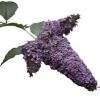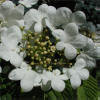Don't
overlook the value of flowering
shrubs as an integral part of
any landscape. With a little effort, plants can be selected
which will keep the flowers coming from early spring and
throughout the summer.
We all know about the common
forsythia,
lilacs and honeysuckles found in most yards. But, there are
many more shrubs that are commonly available that will provide
additional color and, often, fragrance to the home landscape
(USDA Zone 5).
 For
mid-summer flowering, it is hard to beat the - Bottlebrush Buckeye (Aesculus parviflora). This relative of the
- Horsechestnut forms large white spikes of flowers that
standout in the landscape. The large, compound leaves are also
attractive throughout the summer.
For
mid-summer flowering, it is hard to beat the - Bottlebrush Buckeye (Aesculus parviflora). This relative of the
- Horsechestnut forms large white spikes of flowers that
standout in the landscape. The large, compound leaves are also
attractive throughout the summer.
The
butterfly bush (Buddleia davidii) produces clumps of
flowers ranging in color from white to dark purple. As the
name implies, the shrub is attractive to butterflies and
hummingbirds. The stems are marginally hardy for this area
but, if it dies to the ground in the winter, it will produce a
new shrub the following summer from the ground up.
ranging in color from white to dark purple. As the
name implies, the shrub is attractive to butterflies and
hummingbirds. The stems are marginally hardy for this area
but, if it dies to the ground in the winter, it will produce a
new shrub the following summer from the ground up.
 Carolina
allspice (Calycanthus floridus)is a trouble free plant
for the back of the border. Its rust brown flowers are unusual
and the sweet scent of the plant is very pleasant. Check the
plant for fragrance before purchasing it since some of the
newer cultivars may lack it.
Carolina
allspice (Calycanthus floridus)is a trouble free plant
for the back of the border. Its rust brown flowers are unusual
and the sweet scent of the plant is very pleasant. Check the
plant for fragrance before purchasing it since some of the
newer cultivars may lack it.
 An
old standby is the - Flowering Quince (Chaenomeles speciosa)
which now has many hybrid cultivars on the market. Many are
capable of a beautiful display for a couple of weeks in the
spring. Their glossy green foliage provides a good background
for other plants the rest of the time.
An
old standby is the - Flowering Quince (Chaenomeles speciosa)
which now has many hybrid cultivars on the market. Many are
capable of a beautiful display for a couple of weeks in the
spring. Their glossy green foliage provides a good background
for other plants the rest of the time.
 For
fragrance in the later summer, it is hard to beat summer sweet
or (Clethra
alnifolia). This plant
will take partial shade and a moist site. Its fragrant flowers
will be noticed from quite a distance on a warm summer day.
For
fragrance in the later summer, it is hard to beat summer sweet
or (Clethra
alnifolia). This plant
will take partial shade and a moist site. Its fragrant flowers
will be noticed from quite a distance on a warm summer day.
 Small
- Fothergilla (Fothergilla gardenii) is a nice, small
specimen plant for the mixed border. In the early spring, it
produces puffs of white flower spikes. This plant provides
brilliant yellow, orange and scarlet fall color too.
Small
- Fothergilla (Fothergilla gardenii) is a nice, small
specimen plant for the mixed border. In the early spring, it
produces puffs of white flower spikes. This plant provides
brilliant yellow, orange and scarlet fall color too.
 Don't forget new cultivars of rose-of-sharon
(Hibiscus syriacus) for summer color. Some of the named
cultivars have huge flowers and may work as a specimen in the
landscape.
Don't forget new cultivars of rose-of-sharon
(Hibiscus syriacus) for summer color. Some of the named
cultivars have huge flowers and may work as a specimen in the
landscape.

The
mock orange (Philadelphus coronarius) is free flowering
and very fragrant in June. Many cultivars are now available in
a number of different sizes.
 For a lilac type of flower, try the Chinese
lilac
(Syringa chinensis) as an alternative to the
- Common Lilac (Syringa vulgaris). The Chinese lilacs
flower a little later than the - Common Lilac and their flowers
are a bit more "elegant". This species is less susceptible to
the powdery mildew which plagues - Common Lilac in late summer.
For a lilac type of flower, try the Chinese
lilac
(Syringa chinensis) as an alternative to the
- Common Lilac (Syringa vulgaris). The Chinese lilacs
flower a little later than the - Common Lilac and their flowers
are a bit more "elegant". This species is less susceptible to
the powdery mildew which plagues - Common Lilac in late summer.
Every yard should have several different
viburnums (
Viburnum species) as a minimum. There are
several hundred different species and dozens of them are
available in the nursery trade. The doublefile viburnum (Viburnum
plicatum var. tomentosum), Koreanspice viburnum (Viburnum carlesii) and Burkwood viburnum (Viburnum x burkwoodii)
are 3 to consider.
 The
doublefile viburnum has horizontal branching and beautiful
white flowers borne on top of the plant in early spring.
Koreanspice viburnums are hard to beat for fragrance while
their white to pink flowers are in bloom in early spring.
Burkwood viburnums are also fragrant and have glossy,
semi-evergreen foliage on a rounded plant.
The
doublefile viburnum has horizontal branching and beautiful
white flowers borne on top of the plant in early spring.
Koreanspice viburnums are hard to beat for fragrance while
their white to pink flowers are in bloom in early spring.
Burkwood viburnums are also fragrant and have glossy,
semi-evergreen foliage on a rounded plant.
Consider these shrubs to fill that niche in
the landscape. Most of them have many different named
cultivars with different flower colors. Before planting,
consider the ultimate size of the plant and be sure that it
will fit the site when mature. Many of these plants have dwarf
types available too.